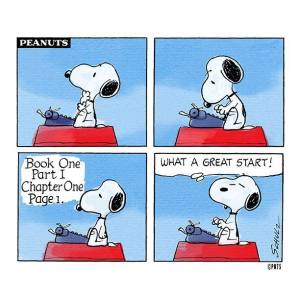A few weeks back somebody asked me to write about how I create outlines. I sincerely apologize for forgetting who asked this and which post the comment was on. I searched, but couldn’t find it. (I sense a post-publishing edit coming.) Anyway, here’s how it all works out and I’ll use Sleeper of the Wildwood Fugue for it:
- Get the idea or join a Dungeons & Dragons game.
- If in a game, get permission to use characters of other players. Puppy dog eyes and purchase of person’s favorite food help.
- Make character, city, monster, and artifact bios in a notebook. Then realize you might be going overboard. Continue being insane and add as ideas form.
- Make a chapter by chapter outline with shorthand details that you can’t decipher in your later years. Any dungeon traps should be mentioned, but NEVER write down how to solve them because OF COURSE you’ll remember 17 years from now. (Young me was an idiot.)
- Start writing the first book. Also realize that typing is faster than hand-writing, so put ‘Idea Book’ on disk.
- Leave disk in Computer Lab, return, retrieve, trip, and drop disk into sewer drain. Cry in private.
- Years pass while writing, editing, and outlining whatever little head comes to your mind.
- Make a fort out the notebooks. Put up ‘No Entry Without Pizza’ sign.
- Decide to make simple blurbs of each future book in case you leave this mortal coil before you’re done. (Only for people who have about 30-35 book ideas in their head.)
- Streamline the character bios and use them to help create personal subplots. Magic items and other special gear can be included in this too. Cities are still a separate thing, but just a basic idea and landmarks can work.
- Keep writing the books and accept that things will change as you write them.
- Change your outlining system to create 2-4 sections per chapter with a ‘plot goal’ and events for each one. Review to see where sections can be combined, omitted, or divided. Check each chapter outline before you hit it to make sure it lines up with previous work.
- Finish writing a book and realize that you did a lot of long-term changes. Rewrite the outline for the next book while changes are fresh. Take a week before looking at it again.
- Repeat outlining, writing book, revising future outline, and resting.
- Make a blog post about your outlining method and evolution. Realize around ‘Step 4’ that what works for you might not work for other people. Start to wonder if you should get out more, see that it’s snowing, and decide to eat a Twizzler.






Perfect. Sounds very organized compared to others I’ve known.
LikeLike
Thanks. I have met several authors who skip outlines and do an amazing job. It all depends on the mindset, I guess.
LikeLiked by 1 person
*raises hand and jumps around like a deranged elementary student* That’s me!!! Ok, so I don’t know about ‘amazing’ job…but the most outlining I do is making notes about specific researching I’ve done (like maritime archeology, salvaging, and rulers/dates for historically accurate fantasy sub plots) and notecards for character bios. Otherwise, my mind changes things too quickly to waste it on outlines 🙂
I like your notebook fort though…I’ll have a sign requesting tacos.
LikeLike
I don’t think I have it in me to work without a plan. Having that outline keeps me at ease. The research side of things does tend to happen as I write. Mostly odd real world facts that come up like what peacocks eat or parts of a ship.
LikeLiked by 1 person
This time I actually researched BEFORE I started writing much. I guess there’s a first time for everything
LikeLike
For me it’s just random things that I add into scenes in the spur of the moment. For example, the peacock thing came from me designing a room for a scene in the recent book. It had peacocks wandering around and getting fed.
LikeLiked by 1 person
In a room? I want to visit that place! Out of curiosity…what DO peacocks eat? I always assumed bird feed…
LikeLike
Hilarious. Coffee on the keyboard funny.
LikeLike
Thanks. 🙂
LikeLiked by 1 person
Ha ha! I especially love the puppy dog eyes method. And number 4 cracked me up, because I’ve done the same thing. I have written notes on small pieces of paper that I couldn’t decipher years later.
LikeLike
I noticed a typo in #4 actually. Then I found myself on that new posting thing that I keep trying to avoid. It’s even worse than I remember.
LikeLike
Love #8.
LikeLike
Thanks. I need a new sign though. 😛
LikeLiked by 1 person
Reblogged this on D.e.e.L's Writing and Various Nonsense.
LikeLike
Thanks for the Reblog.
LikeLiked by 1 person
I enjoyed the humour in your list. I was beginning to envy you for such intricate planning, and then I realised that even I do some of that (though I hate to plan) 🙂
LikeLike
There’s always some hint of planning. At least an idea of where you want to go, I guess.
LikeLiked by 1 person
Yes, an outline, no matter how brief, is an outline!
LikeLike